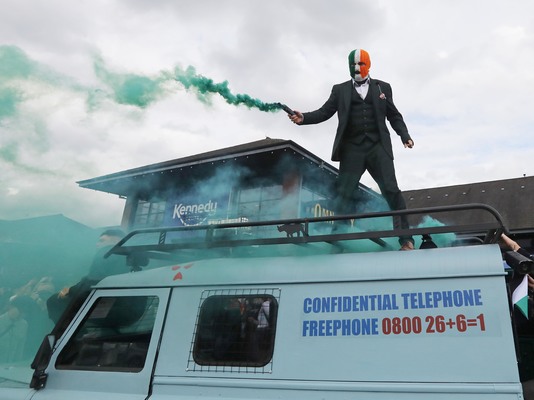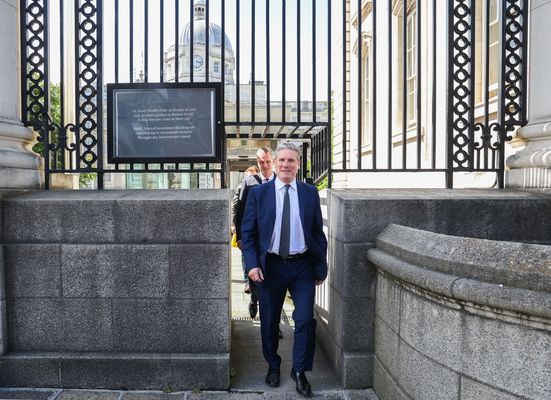IN the 49 days of Israeli bombing of the Gaza Strip up to the ceasefire, the Euro-Med Human Rights Monitor reports 20,031 killed and over 36,000 injured. The dead include 8,100 children, many of whom remain buried under rubble. Up to 900 children have had limbs amputated. Among the dead are 210 medical staff, over 100 teachers and 67 journalists. The intensity of the killing alone means the war is well over a thousand times worse than what was experienced in our own thirty-year conflict.
If you listen to anything today let it be this:
— Dr. Jennifer Cassidy (@OxfordDiplomat) November 26, 2023
UN Under- Secretary- Generalfors Humanitarian Affairs, Martin Griffiths, and seasoned British Diplomat stated:
“68% of the people killed in Gaza are killed are women and children. They stopped counting the number of children… pic.twitter.com/ots98TAqt3
Three-quarters of the people of Gaza are now displaced because of the carpet bombing and wholesale destruction of housing, schools and hospitals, of which only nine out of 36 are still functioning. That’s according to surgeon Professor Ghassan Abu-Sittah who recently returned to London after 41 days of gruesome work in Gaza. He says he treated wounds from white phosphorus, the use of which is a war crime in some circumstances. In October alone, 18,000 tonnes of bombs were dropped, the equivalent of 1.5 Hiroshima atomic bombs. That figure more than doubled by the time of the temporary ceasefire.
The people of Gaza have been deprived of basic aid and hospitals prevented from receiving fuel for generators. The tens of thousands who are wounded are dying for lack of treatment, dressings and drugs. Desalination plants are not working, people are starving, and sickness is widespread from lack of clean water and toilet facilities.
Having ordered the residents of north Gaza to move south for safety, the Israelis then bombed the south, killing more than 3,700. People in the south were then told to move to a narrow coastal strip at Mawasi. Incredibly, about 300,000 stayed in the north and a few tried to return there during the ceasefire, only to be shot at by IDF ground troops. As the head of the World Health Organisation told the UN Security Council two weeks ago, “nowhere and no one is safe” in Gaza: a child is killed every ten minutes. The psychological damage is incalculable.
Beyond Gaza in the occupied West Bank, 239 Palestinians have been killed over the past seven weeks. Many more – 3,260, including 120 women and 200 children– have been detained at checkpoints or in house raids. While the Israelis have to date (27 November) exchanged 150 Palestinian prisoners/detainees for 51 Hamas hostages, they have detained many more Palestinians than the number released, adding to the 7,200 population of prisoners held under sentence or “administrative detention” – what we would call internment without charge or trial. The bodies of Palestinians who die in prison (at least six since 7 October) are often held indefinitely by the Israeli authorities, rather than handed over to families.
While the Israeli government appears united on the military aim of defeating Hamas, it is no closer to agreeing a political objective for Gaza or Palestine as a whole. Is it to replace Hamas with a more compliant administration or is it, as the most extreme faction would like, to push the entire population of Gaza into Egypt, alongside an ever more aggressive settler take-over of the West Bank?
And what of Hamas? Its actions on 7 October triggered a predictable response from the Israelis, even if more vicious and long-lasting than might have been anticipated. But to what political end? To prove it is less compliant with the Israelis than Fatah and the Palestinian Authority? The bottom line in Hamas’ political document of 2017 is, after all, essentially the same as Fatah: the creation of a Palestinian state on the borders of 1967.
Neither the Israelis nor Hamas seem to have a strategy so there is an urgent need for international intervention. This is the view of Dr Tony Klug, one of the leading advocates of the so-called two-state solution – the establishment of a Palestinian state alongside an Israeli state. He can be heard discussing this and the unitary state alternative in a very informative podcast which mentions our own peace process.
This is not to say that Netanyahu, the Israeli prime minister, and his far-right cabinet allies lack an objective. Their dream is to take complete possession of the West Bank and to make life miserable for Palestinians who remain, in the hope that they will eventually leave – for Jordan or wherever. This faction does not care what other countries may think of it in the process. But this is a military objective, not a political strategy for achieving long-term peace and security for the Middle-East. Making war on Hamas makes it much harder to achieve an agreement with neighbouring Arab states that brings peace and security to the Middle-East.
🔴 It's the Occupation, Stupid!
— Omar El-Haddad (@oelhaddad) November 18, 2023
By Tony Klughttps://t.co/ofx240GIrr#CeasefireInGazaNOW#GazaHolocaust#Palestine_Genocide pic.twitter.com/Wv4i2dHTX9
Klug argues that, since 1967, every peaceable advance and political initiative has followed “a seismic event”, though none have been on the scale of the present catastrophe. Since the 1980s, peace talks have always started with the end game, revolving around two states, followed by negotiations over the logistics of how to implement a deal. But if the deal is two states and the current Israeli government refuses to accept that, then there is nothing to negotiate – no peace talks or political process.
The US administration is the least qualified to lead any international intervention that can end the mass killing. The US and its junior partner in these matters, Britain, not only support the Israeli war on Hamas politically, but also supply much of the weaponry.
UK arms sales are being used to fuel Israel’s attack on Gaza! Download the new Fact Sheet, “Gaza and UK Arms Sales to Israel” to get CAAT’s latest research on what UK military gear is being sold to Israel and where we think it is being made. https://t.co/bCnxWi2evl
— CAAT (@CAATuk) November 14, 2023
There is also the corrosive failure of the US and other western states historically to do anything about Israel’s illegal occupation of the West Bank and Gaza, and its illegal plantation of settlers in occupied territories which has accelerated in recent years. There have been no negative consequences for these persistent breaches of the Geneva Convention. Over decades, Israel has learnt to get away with it.
I’m appalled to learn that in the middle of a war, the Israeli gov is poised to commit new funds to build more illegal settlements.
— Josep Borrell Fontelles (@JosepBorrellF) November 27, 2023
This is not self-defence and will not make Israel safer. The settlements are grave IHL breach, and they are Israel’s greatest security liability.
Within Israel itself, Netanyahu has negligible support. He is blamed for the intelligence and security failings that led to the Hamas killings and hostage taking on 7 October. The mobilisation of 300,000 reservists and the shuttering of whole areas of the economy is proving costly – $260 million every day, says Bloomberg. Yet Netanyahu’s political project will probably live on after he has left the scene, at least in the immediate future.
For @gdnlongread, I wrote about the collapse of Benjamin Netanyahu’s entire political project—and why, despite that, it could well live on even after he’s gone. https://t.co/VHSoqOnRC7
— Joshua Leifer (@joshualeifer) November 21, 2023
Hope lies in the popular opposition to Israel’s devastation of Gaza. This is growing the world over and Israel’s traditional allies will soon find themselves on the wrong side of history.
The BBC admits what many of us have been saying for some time: The damage Israel's war is inflicting on the US/EU's global standing due to their refusal to pressure Israel to stop the carnage will reach a point in which the West will be forced - out of pure self-interest - to… pic.twitter.com/KC4esnIGe3
— Trita Parsi (@tparsi) November 24, 2023







